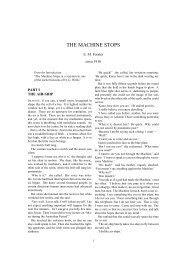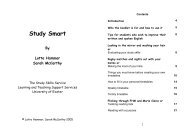PDF - The Metaphysics of Virtual Reality - University of Exeter
PDF - The Metaphysics of Virtual Reality - University of Exeter
PDF - The Metaphysics of Virtual Reality - University of Exeter
Create successful ePaper yourself
Turn your PDF publications into a flip-book with our unique Google optimized e-Paper software.
Monads Do Have Terminals<br />
Leibniz called his metaphysics a monadology, a theory <strong>of</strong> reality describing a system<br />
<strong>of</strong> "monads." From our perspective, the monadology conceptually describes the nature<br />
<strong>of</strong> beings who are capable <strong>of</strong> supporting a computer matrix. <strong>The</strong> monadology can<br />
suggest how cyberspace fits into the larger world <strong>of</strong> networked, computerized beings.<br />
<strong>The</strong> term monadology comes from the Greek monas, as in "monastic," "monk,"<br />
and "monopoly." It refers to a certain kind <strong>of</strong> aloneness, a solitude in which each being<br />
pursues its appetites in isolation from all other beings, which also are solitary. <strong>The</strong><br />
monad exists as an independent point <strong>of</strong> vital willpower, a surging drive to achieve its<br />
own goals according to its own internal dictates. Because they are a sheer, vital thrust,<br />
the monads do not have inert spatial dimensions but produce space as a by-product <strong>of</strong><br />
their activity. Monads are nonphysical, psychical substances whose forceful life is an<br />
immanent activity. For monads, there is no outer world to access, no larger, broader<br />
vision. What the monads see are the projections <strong>of</strong> their own appetites and their own<br />
ideas. In Leibniz’s succinct phrase: "Monads have no windows."<br />
Monads may have no windows, but they do have terminals. <strong>The</strong> mental life <strong>of</strong> the<br />
monad—and the monad has no other life—is a procession <strong>of</strong> internal representations.<br />
Leibniz’s German calls these representations Vorstellungen, from vor (in front <strong>of</strong>) and<br />
stellen (to place). Realities are representations continually placed in front <strong>of</strong> the viewing<br />
apparatus <strong>of</strong> the monad, but placed in such a way that the system interprets or<br />
represents what is being pictured. <strong>The</strong> monad sees the pictures <strong>of</strong> things and knows<br />
only what can be pictured. <strong>The</strong> monad knows through the interface. <strong>The</strong> interface<br />
represents things, simulates them, and preserves them in a format that the monad can<br />
manipulate in any number <strong>of</strong> ways. <strong>The</strong> monad keeps the presence <strong>of</strong> things on tap, as<br />
it were, making them instantly available and disposable, so that the presence <strong>of</strong> things<br />
is represented or "canned." From the vantage point <strong>of</strong> physical phenomenal beings, the<br />
monad undergoes a surrogate experience. Yet the monad does more than think about<br />
97
















